
December 2011
John Vincent Bellezza
The Flight of the Khyung begins anew as the end of the year approaches. As promised, this month’s issue is devoted to the intriguing rock art masks of Upper Tibet and to searching out their kith and kin across Inner Asia. This is my first stab at this fascinating subject matter, something to get me and readers thinking more deeply about the so-called mascoids. A more rigorous academic paper is forthcoming, but I shall begin by putting my thoughts down in this newsletter. If you have any feedback on the subject or want to share information, please send me an email. Substantive contributions will of course be noted in any publication that refers to them.
The individual or group in emblematic form: the mascoids of Upper Tibet
One of the most distinctive genres of rock art in western Tibet is the human form in which compositions are dominated by the head. This type of rock art is directly comparable to the so-called mascoids of southern Siberia, Xinjiang, Qinghai plateau (Amdo), Ladakh, and Indus Kohistan. It has been presumed that rather than the human countenance itself, this art depicts ritualistic masks used to cover the face, thus rock art specialists have coined the rather odd name ‘mascoid’ to describe them. While mascoids found in southern Siberia and the steppes are indeed like human heads (modified by zoomorphic and preternatural features), those of Upper Tibet are much more stylized. That some Tibetan specimens are in fact heads or heads encompassing the torso is borne out by the addition of arms and legs to them.
Primarily on stylistic grounds (a powerful but by no means an always reliable analytical tool), the mascoids of north Inner Asia are conventionally dated to the Bronze Age. They are most strongly identified with the Okunev culture (first half of the second millennium BCE) of the Minusinsk basin (southern Siberia), an ‘archaeological culture’ (defined through interrelated sets of artifacts and burials) that is thought to have spread its influence to the eastern steppes. The Okunev site of Mugur-Sargol has lent its name to a class of mascoids characterized by round or oval heads surmounted by horns or antennae, and human-like eyes, noses and mouths (these are well studied in M. A. Devlet’s 1980 book, Petroglify Mugur-Sargola. Moscow: Nauka).
Mascoids similar to the Mugur-Sargol type are found as far east as the Helankou site in Ningxia and Yinshan in Inner Mongolia. Mascoids in a style allied to the Mugur-Sargol type are also known in the rock art of Indus Kohistan (in the vicinity of Chilas). These too have been dated (using non-direct methods) to the Bronze Age by rock art experts such as H.-P. Francfort, K. Jettmar and V. Thewalt. The mascoids of Ladakh have been carefully catalogued by Laurianne Bruneau, who was recently awarded a doctoral degree from the Sorbonne for her study of rock art. Dr. Bruneau initially classified the mascoids of Ladakh into five categories. Although the Ladakh mascoids are distinctive, Bruneau’s types I and 2 share some esthetic features in common with the mascoids of Siberia and the steppes. Cognate attributes include round heads and pairs of triangular patches. The bases of these triangles conform to the outline of the face, while the apexes point towards the eyes and nose (sometimes enclosing them).
The Ladakh mascoids, while easily recognizable as anthropomorphic renditions, consist generally of more abstract interpretations of the human visage than the steppic examples. The mascoids of Upper Tibet are even more highly stylized and they are characterized by complex ornamentation consisting of linear and curvilinear motifs. Recently, working in collaboration with me, Dr. Bruneau has indentified two more types of mascoids in the Ladakh rock art record. These two types share close design affinities to those of Upper Tibet. In esthetic terms, Ladakh therefore is a bridge between the mascoids of the steppes and the mascoids of Upper Tibet. After presenting the mascoids of Upper Tibet, we shall explore the potential implications of these esthetic transformations through geographic space.

Fig. 1. On this single boulder in Upper Tibet at least ten mascoids were carved.
I am not aware of any other Inner Asian site where so many mascoids are arrayed in such close quarters (but at the moment I have few publications on the subject at my fingertips). Found at the epicenter of mascoid rock art in western Tibet, I have documented around 40 examples of the genre at this one site. The mascoids of this locale are deeply carved, very adeptly executed and heavily repatinated with so-called desert varnish (the mineralized veneer that forms over rock art with age). The physical presentation of these rock art portrayals indicates that they are of very substantial age. Each mascoid is unique and exhibits a different array of motifs. Most of the specimens on this boulder are particularly abstract in form with few recognizable anthropomorphic traits. In addition to the mascoids, there are animals gracing the boulder. The physical evidence indicates that these zoomorphic depictions were produced in the same timeframe as the mascoids. In fact, they appear to be an integral part of the suite of carved images.
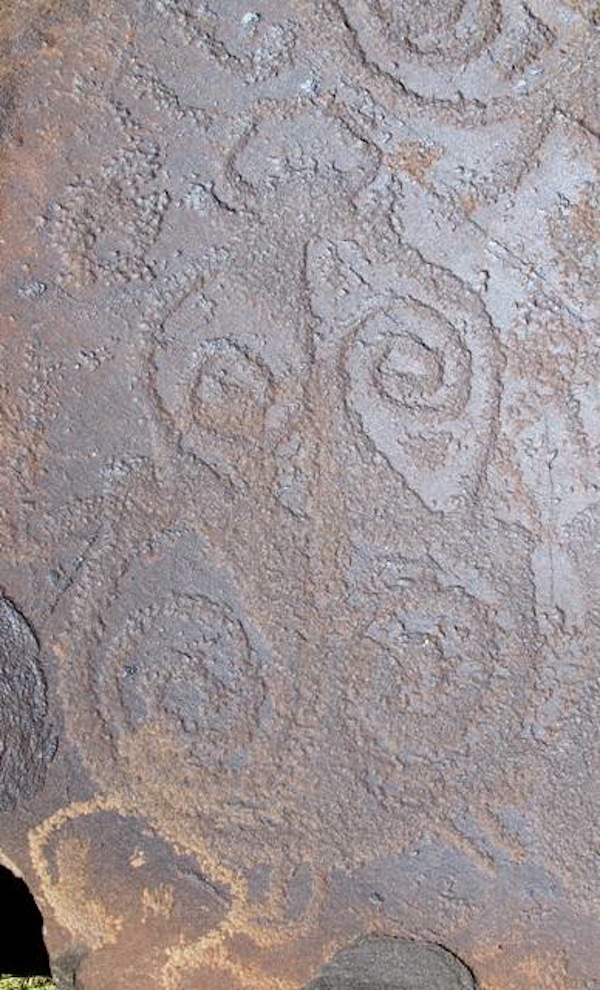
Fig. 2. Like most of the mascoids of Upper Tibet this specimen from the above boulder has a constricted midsection. What may represent horns is found on top of the head. The interior of the mascoid is filled with two pairs of spirals divided by a vertical axis. What appear to be legs are found below the body.
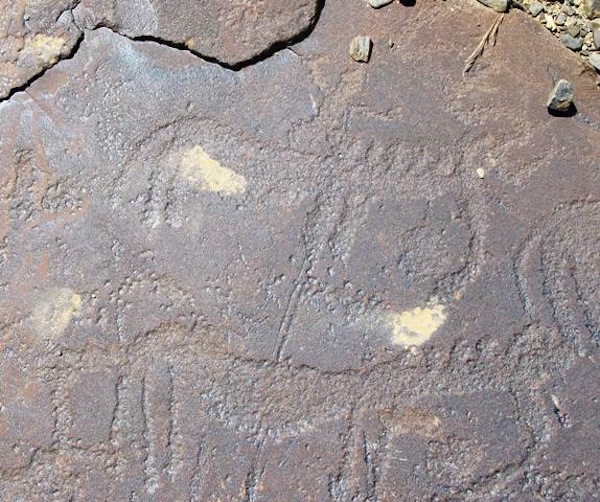
Fig. 3. Two equids (probably horses) on the same boulder as the mascoids shown above.
The upper equid is mounted by an anthropomorphic figure (its head, outstretched arms and legs are discernible). The identity of the rider is ambiguous; it could either be the representation of a human or a divine being. Be that as it may, at the same rock art site there are many depictions of mounted hunters that appear to date to the same general period as the mascoids. The presence of equestrians indicates that such rock art was not produced before the early Iron Age. On the basis of its erosional characteristics, technique of manufacture and stylistic make-up, a substantially later date for this rock art is not very likely. It is conceivable that some mascoid rock art isolated from horsemen may be of an earlier date and should be given a late Bronze Age attribution. We can speculate all we want on the age of the mascoids but until more stringent methods of dating rock art are perfected, a good deal of caution is warranted. I cannot therefore accept unequivocally any of the chronological claims made about mascoids by rock art specialists working in north Inner Asia. That is not to say they are wrong in their judgments but that scientific verification for the most part is still lacking.
In addition to the human likeness, a number of wild yaks were also carved on the boulder in the same timeframe. The Upper Tibetan way of life was and still is very much dependent on the yak, first as a wild creature and then as a domesticated animal. Whatever the purpose of the mascoids, the depiction of wild yaks was seen as an important part of its articulation. It may possibly be that the mascoids, yaks and horseman depicted in association with one another encapsulated the economic and spiritual life of the community in toto, a demonstration of its most cherished beliefs and values.
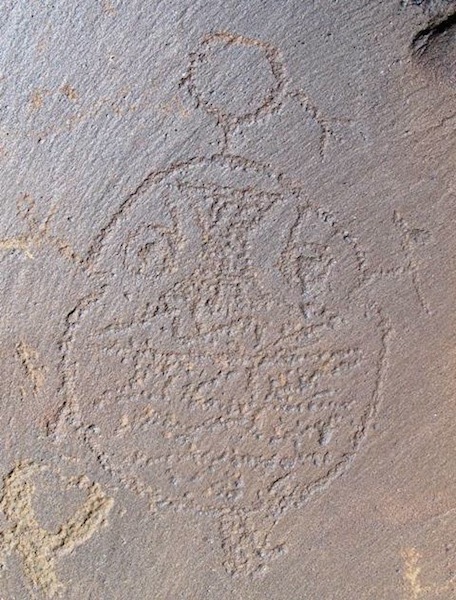
Fig. 4. A mascoid first documented in 2000.
It was only more recently that I realized this was a mascoid so different is it from north Inner Asian counterparts. Yet, the round object on the top of the head is a feature found in the mascoids of Mugur-Sargol as well. The Upper Tibet specimen is depicted with both arms and legs, which are of insignificant size. In the left hand the figure holds an object that resembles a banner or spear with an ensign, ancient military equipment well documented in Tibetan texts. It is the face with its eyes and nose that dominates the composition. The lower half of the circle is filled with fine lines but no regular pattern can be discerned. The sides of the face are pinched, a typical trait of Upper Tibetan mascoids.
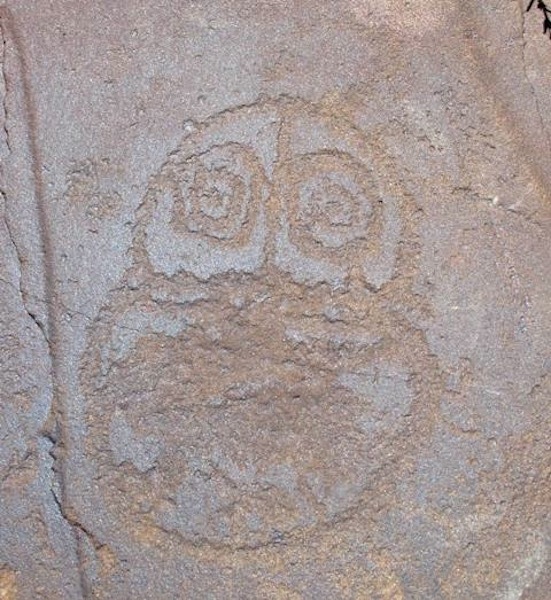
Fig. 5. This bi-circular mascoid has large eyes composed of three concentric circles. The lower half of the face has an engraved middle portion. On top of the head there is a round object (representing a hair knot or a finial on a hat or helmet?).
The abstract nature of the Upper Tibetan mascoids lends them a symbolic aura while the complexity of their design suggests that they enshrined intricate intellectual and/or behavioral traditions. As noted, every mascoid in Upper Tibet is unique. While they share many basic attributes in common, each is finished in various ways, as it they were representative of different individuals, clans or tribes. Perhaps therefore they were carved as social emblems, marking the special identity or function of individuals or groups. Seen as such, the mascoids may have been genealogical in nature, demarcating various lineages or ancestral legacies. Rather than masks per se (such as that worn by Himalayan and Inner Asian shamans more recently), I am inclined to see the so-called mascoids of Upper Tibet as a kind of standard that served a heraldic or armorial function. I hasten to add that I am not directly comparing the mascoids with medievel European political traditions, but rather with the underlying concept of clearly defined martial functionaries embodying concepts and activities valued by society at large.
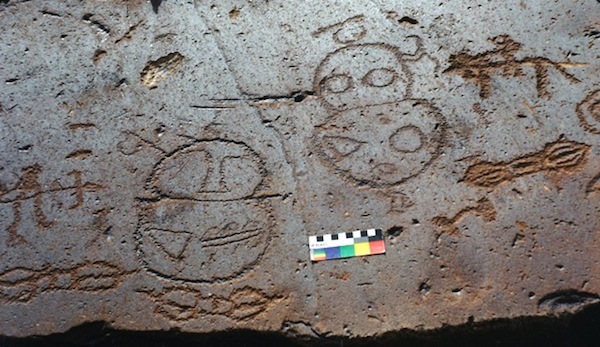
Fig. 6. These two mascoids were first documented in 2000 on the Upper Tibet Circumnavigation Expedition. The figure on the right holds what appears to be a bow in his left hand and there is something in the right hand of the left figure as well. Both mascoids are topped by curvilinear objects. They are surrounded by figures of a later period, including a horseman, a bowman and what appears to be three dorjes (rdo-rje, vajra), the adamantine thunderbolt of Tibetan Buddhism. The dorje is itself a seminal cultural symbol and placement next to the mascoids suggests their maker appreciated that they too once had great cultural significance.
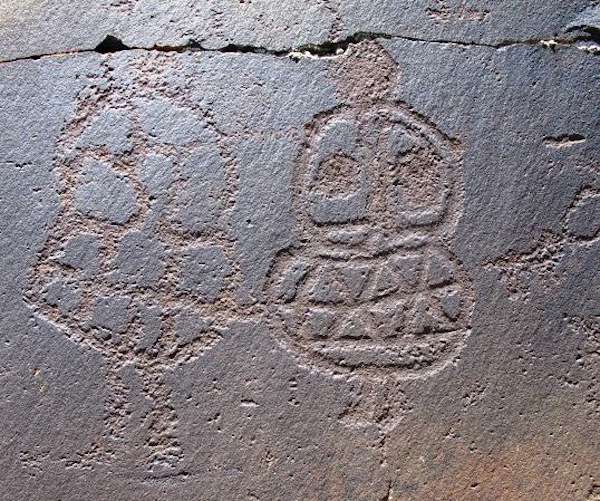
Fig. 7. This pair of mascoids is joined in the middle by a single line. We might read into this that a male and female are depicted and, if we are feeling romantic, that these are lovers forever immortalized in stone. However, a more pedestrian explanation is that they are possibly emblematic of parallel matrilineal and patrilineal traditions (called cho and ’brang in the Old Tibetan language). But we do not really know. The specimen on the right has exaggeratedly large eyes and two rows of triangles in the lower half of the face. To its right is a wild yak of the same general time period in a style typical of highland Tibet. The specimen on the left is divided into 11 or 12 rounded segments. Both mascoids have legs and feet.
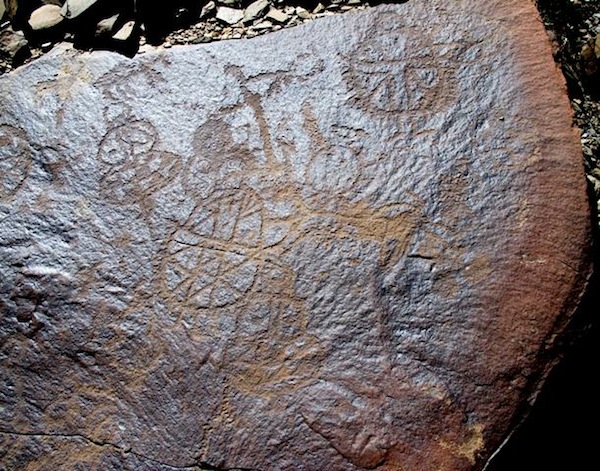
Fig. 8. Some of nine or ten mascoids engraved on the horizontal top of a boulder.
These carvings are also found at the epicenter of mascoid rock art in Upper Tibet. Mascoids have only been documented in western Tibet. While they exist far to the northwest on the Qinghai Plateau and in Inner Mongolia, other portions of Upper Tibet are devoid of this genre of art. This suggests that any intercultural communications which influenced the creation or adoption of mascoids in upland Tibet came from the north or west rather than traveling across the Tibetan plateau from east to west. In my book Zhang Zhung (Austrian Academy of Sciences: 2008), I make the same geographical observations as regards Upper Tibetan archaic funerary monuments.
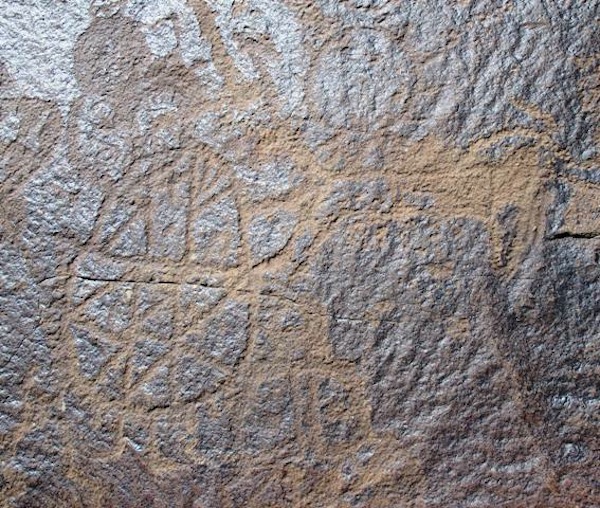
Fig. 9. The middle portion of the above boulder is filled with a mascoid closely flanked by lesser ones. This gives the impression that the central example is the leading figure perhaps in a political, religious or ancestral sense, the others being ancillary to it. Immediately to the right of the central mascoid and connected to it by one or more lines is what appears to be a bovine or equid (possibly it is a pair of animals directly in line with one another so that little of the more distant animal can be seen). The elongated rectilinear form of this animal will be instantly recognizable to students of Inner Asian rock art and which is conventionally dated to the Bronze Age. Perhaps this is a pair of draught animals such as those that pulled carts or chariots. The animal(s) have that kind of general appearance. If so, the central mascoid may be depictive or emblematic of the (archetypal) operator of wheeled vehicles.
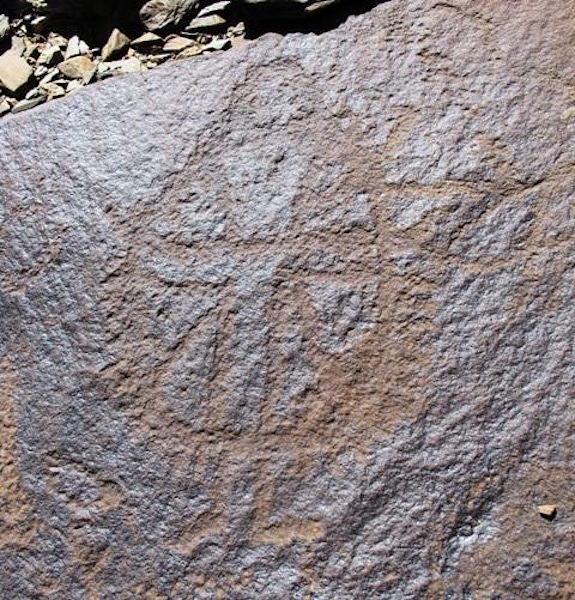
Fig. 10. This mascoid wields what appears to be a bow in the left hand. The smaller round form on top seems more like a head while the large circle with radiating lines seems more like a torso. Legs appear below the body. The torso is ornamented with a cruciform motif and intermediate diagonal lines. We might speculate that these particular designs appeared in other media as well such as shields and ritual objects, hallmarks of individuals or aggregates of individuals, which fulfilled specific social functions or religious purposes.
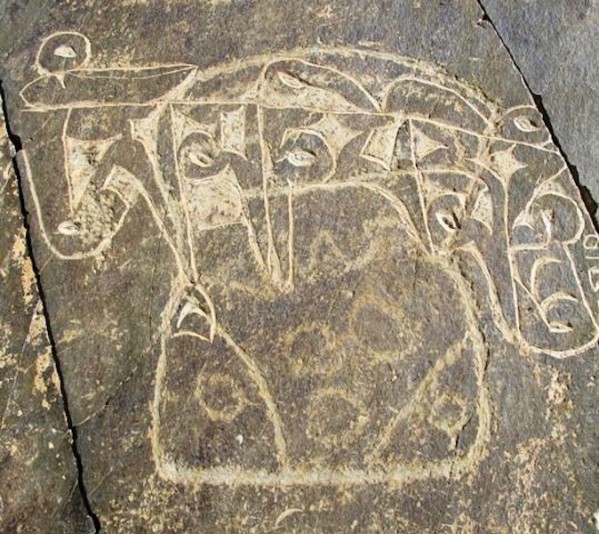
Fig. 11. A mascoid of more rectilinear proportions over which the six syllable mani mantra was carved. The variable levels of repatination exhibited by the mascoid and mantra are clearly recognizable. The lower part of the figure is ornamented with five circles. The internal features of the upper half of the mascoid have been largely obliterated by the letters. The superimposition of Buddhist inscriptions and motifs on earlier rock art is a common occurrence in Upper Tibet.
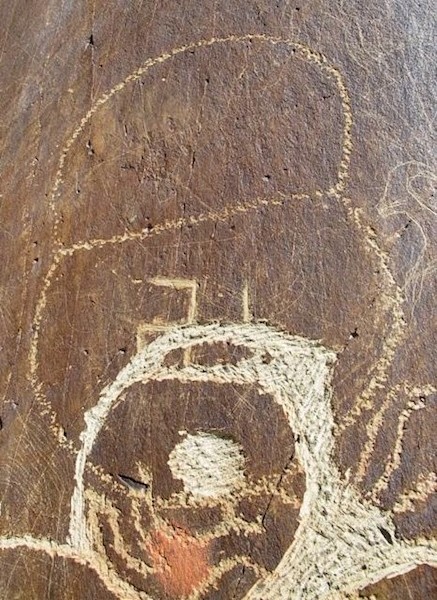
Fig. 12. This bi-circular mascoid is of a type also encountered in Ladakh. For the Ladakh examples see the article “Petroglyphs of Ladakh: The Withering Monuments” by Tashi Ldawa Tshangspa, published online on Tibet Heritage Fund website (www.tibetheritagefund.org/pages/posts/withering-heights30.php). Also, see “An Archaeological Account of the Markha Valley, Ladakh” by Q. Devers and M. Vernier, published in the online journal Revue d’Etudes Tibétains, vol. 20, 2011.
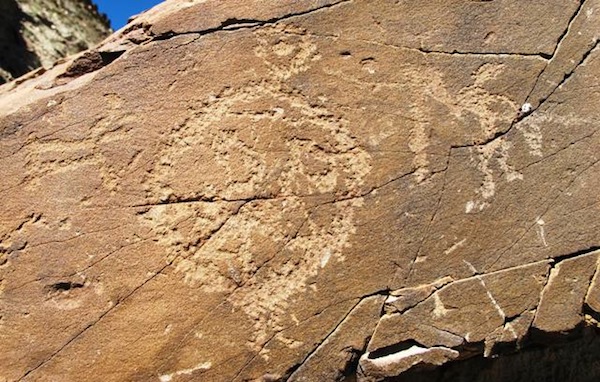
Fig. 13. Although all the Upper Tibetan mascoids thus far depicted in this newsletter appear to date to the Iron Age or perhaps in certain cases to the Bronze Age, cruder examples from later times are also encountered. In this image we see a mascoid with typical regional features (legs, complex interior ornamentation and smaller upper circle). It is flanked by a wild herbivore and a standing anthropomorph. This more crudely rendered mascoid was carved with shallow lines and has not undergone as much repatination as others we have examined. As is other rock art in the close vicinity, this composition is best dated to the protohistoric period (100 BCE–650 CE). The maker of this image must have gained inspiration from older mascoid art found in the area. Perhaps his carving was a tribute to distant ancestors and those things they held dear.
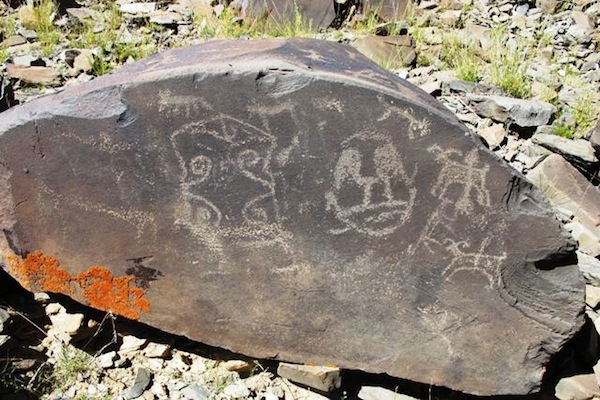
Fig. 14. Two later mascoids found at the epicenter of this genre of rock art. The shallow carving and style of companion animals indicate that this is another example of protohistoric period rock art. The artist was savvy enough to create his mascoids in both major head shapes: circular and rectangular.
A big question concerning the mascoids of Upper Tibet is what do they tell us about the interrelationship between western Tibet and other regions of Inner Asia in prehistory? As shown by the mortuary archaeological record of Upper Tibet and by Tibetan archaic funerary texts, correspondences between the material culture of the plateau and the steppes are clear and compelling. Nonetheless, explaining how these parallels came about and what they tell us about cultural sharing and the movements of people is anything but settled. The artistic forms and companion ideas that these forces gave rise to traveled over vast distances in Bronze Age and Iron Age Inner Asia. That Upper Tibet was embraced by long-range exchanges, however, is only now getting the attention such an important piece of the Eurasian ethnical and historical mosaic deserves.
Ladakh is our geographic linchpin, for it gave rise to mascoids exhibiting both north Inner Asian and Upper Tibetan esthetic elements. While the Ladakh genre of mascoids taken as a whole is unique, it appears to have directly borrowed or to have been more generally inspired by the rock art of the steppes. A debt to Upper Tibet may also be suggested, as seems to be the case with other archaeological materials (such as wild ungulate rock art with double volute ornamentation and all-stone corbelled residential architecture), which are far better developed in that region. Nevertheless, artistic flows in the opposite direction may actually be indicated, with analogous mascoids first appearing in Ladakh (among Bodic peoples?) before being transferred east onto the Changthang. If transmission was indeed from west to east, the various types of mascoids found at the Upper Tibetan epicenter of this art may be an offshoot of the typologies common to both Ladakh and upland Tibet. That is to say, mascoids art continued to be transformed as it moved east, subject as it probably was to differing cultural and ethnical environments.
How precisely the Metal Age ethnos and culture of Ladakh was enriched by its neighbors to the north and east remains to be determined. Direct person-to person contacts and the flow of genes in highly complex transactions can be theorized. Trade, war, vassalage, colonization, intermarriage, and pilgrimage are mechanisms by which this enrichment may have been brought about, as reflected in mascoid rock art. It is also possible that some interregional linkages were indirect in nature, Ladakh being caught up in the zeitgeist of those times. Important technological and cultural innovations may have been transmitted through ever shifting human orders, a contagion that spread over time and space along the margins of pastoral communities; a contagion with no single geographic direction or conscious intention per se. Thus, the creation of Ladakh’s mascoids may not only be accounted for by the region having been washed over by a sea of foreign human beings and ideas, but also by this region having been a part of that very same ocean; its diverse demographic, technological and intellectual waters continually intermingling.
For those who care about such technical considerations, I include an edited excerpt of a letter sent to a colleague back in July:
I have just finished reading Michael Frachetti’s important book, Pastoralist Landscapes and Social Interaction in Bronze Age Eurasia (2008). I find much merit in Frachetti’s ideas about the socioeconomic character of localized landscapes having played a major role in fostering wider regional networks, through interactions that take place at the interstices of ever-changing pastoral groupings and strategies. I also have my reservations. In my opinion, while Bronze Age Eurasian homologies can indeed be conceived of as having arisen out of a welter of alinear forces (at least in some cases); symmetries versus vectors, more conventional theories of demic diffusion, colonization, long distance trade, etc. cannot be so easily discarded. In other words, Frachetti’s theory is an alternative not a replacement to understanding the mechanisms behind the transfer of material cultural elements over wide areas. This is most obvious in his argument about the Seima-Turbino phenomenon.
More fundamentally, while Franchetti postulates the absorption of material culture as having to do with the enhancement of the social status of individuals and groups, he fails to provide us with an anthropocentric reason as to why this is so. Very simply, an explication of ideology or the cognitive argument, must be brought to bear, for we are dealing with human beings (however long dead), whose beliefs played a role in the adoption and adaptation of material culture. In this regard, the treatment of ‘religion’ is most useful as difficult as this subject is. The Bronze Age in Eurasia was of course a time well before the rise of the proprietary religions of the Iron Age and classical period, and their use as instruments for the imposition of social and political systems. Nevertheless, Bronze Age Eurasian religious traditions are almost certain to have also played a crucial role in propagating over vast swathes of territory technologies charged with profound ideological significance. For instance, a dagger was more than a tool and more than a socially prized object in Bronze Age Eurasia. It was liable to have symbolized or encoded information related to the mythic and ritualistic. As a motivational factor, ideology ushered in as undergirding the social dynamic that gave impetus to the dissemination of material cultural objects, which Franchetti speaks of in his book, makes his theory less mechanistic, bringing it more in line with actual shared human experience.
Next month: More ancient art of Upper Tibet. Be prepared for some real surprises!